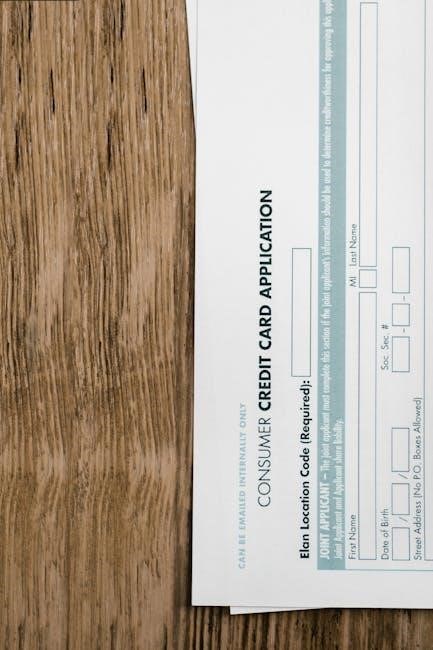Form 410 is a standardized rental application used in Ontario to streamline the tenant screening process, ensuring applicants provide necessary personal, financial, and rental history details efficiently.
1.1 Overview of the Form
Form 410, developed by the Ontario Real Estate Association (OREA), is a standardized rental application designed for residential properties in Ontario. It collects essential information about applicants, including personal details, rental history, employment, and financial status. The form also includes sections for references and additional information, helping landlords or property managers evaluate potential tenants. Its structured format ensures consistency and fairness in the application process. By using Form 410, landlords can efficiently assess applicants while complying with legal standards. This form is widely recognized and recommended for its clarity and comprehensiveness in Ontario’s rental market.

1.2 Importance in Ontario’s Rental Process
Form 410 plays a crucial role in Ontario’s rental process by providing a standardized framework for landlords and tenants. It ensures that all necessary information is collected efficiently, reducing potential disputes and misunderstandings. The form’s structured approach helps landlords evaluate applicants fairly and consistently, promoting transparency in tenant selection. Additionally, it protects both parties by documenting key details, such as rental history and financial stability, which are essential for making informed decisions. By using Form 410, landlords can streamline their screening process and maintain compliance with Ontario’s rental regulations, contributing to a smoother and more professional rental experience for all parties involved.

Key Sections of the Form
Form 410 includes sections for applicant information, rental history, employment and financial details, references, and additional information, ensuring a comprehensive evaluation of potential tenants.
2.1 Applicant Information
The Applicant Information section requires the full name, current address, contact details, and date of birth for all applicants. This section ensures landlords can verify identities and maintain communication throughout the rental process. Accurate information is crucial for evaluating applications fairly and efficiently. Applicants must provide valid phone numbers and email addresses to facilitate follow-ups. This section establishes the foundation for the rest of the application, ensuring landlords have essential details to proceed with further checks. Incomplete or inaccurate information may delay the process or result in rejection.

2.2 Rental History
The Rental History section requires applicants to provide detailed information about their previous landlords, rental addresses, tenancy dates, and monthly rent amounts. This section helps landlords assess the applicant’s rental behavior and reliability. Applicants must list their past rental properties, including the duration of tenancy and the amount paid. Landlords use this information to verify the applicant’s history of timely payments and proper maintenance of the property. Accurate and complete rental history is essential for a smooth evaluation process. Incomplete or misleading information may lead to delays or rejection of the application. This section is critical for landlords to make informed decisions.
2.3 Employment and Financial Information
This section requires applicants to provide details about their employment status, job title, employer, and length of employment. They must also disclose their monthly income and sources of income. Financial information, such as bank account details and savings, may be requested to assess stability. This section helps landlords evaluate the applicant’s ability to afford the rent and meet financial obligations. Applicants may need to attach proof of employment, pay stubs, or bank statements. Accurate and complete financial disclosure is crucial for landlords to assess the applicant’s reliability and ensure timely rent payments. This information is vital for a thorough evaluation process.
2.4 References
This section requires applicants to provide professional and personal references to verify their credibility and reliability. Applicants typically list previous landlords, employers, or other individuals who can confirm their rental history and financial responsibility. Landlords use these references to assess the applicant’s trustworthiness and likelihood of meeting rental obligations. Providing accurate and complete reference information is essential, as false or misleading details may result in application rejection. References help landlords make informed decisions and ensure a smooth rental process. This step is critical in evaluating potential tenants and maintaining a positive landlord-tenant relationship. Accurate references are vital for a successful rental application.
2.5 Additional Information

This section allows applicants to provide supplementary details that may influence the rental decision. It often includes special requests, vehicle information, pet details, or other relevant circumstances. Applicants may also list additional occupants not previously mentioned. This part of the form helps landlords assess potential tenancy conditions, such as pet ownership or required modifications to the property. Providing accurate and complete information here ensures transparency and helps landlords evaluate the application fairly. It is essential to disclose any factors that could impact the tenancy, as withholding information may lead to complications later. This section is crucial for a comprehensive rental application. Accuracy is key here.

Step-by-Step Guide to Completing the Form
This section outlines the process to fill out Form 410, ensuring all necessary details are provided efficiently. Follow each step carefully for a smooth application.
Step 1: Fill in the statement with the property address, desired move-in date, and monthly rent.
Step 2: List all applicants, including their full names and contact information.
Step 3: Provide a detailed rental history, including past landlords and tenancy durations.
Step 4: Disclose employment and financial information, such as income sources and bank details.
Step 5: Include references, both personal and professional, to verify credibility.
Step 6: Review the form for accuracy and sign it to confirm the information provided.
3.1 Step 1: Fill in the Statement
Begin by filling in the statement section at the top of Form 410. This includes the property address, the desired move-in date, and the monthly rent amount. Ensure all details are accurate, as this sets the foundation for your application. Clearly specify the rental term and the number of occupants. This step is crucial for establishing the basis of your rental agreement. Make sure to print neatly or type the information to avoid any misunderstandings. Once completed, proceed to the next section to list all applicants. Accuracy here ensures a smooth process for both you and the landlord or property manager.
3.2 Step 2: List All Applicants
In this section, list all applicants who will be residing in the rental property, including co-applicants and guarantors if applicable. Provide each applicant’s full name, date of birth, current residential address, and contact information. Clearly state the relationship between applicants if they are applying together. Ensure all details are accurate and up-to-date to avoid delays in processing. If minors are applying, additional documentation may be required. Listing all applicants ensures transparency and accountability for the tenancy. This step is essential for landlords to assess the suitability of all potential occupants. Make sure to include any guarantors and their contact information as well. Accuracy is key.
3.3 Step 3: Provide Rental History
In this step, you must detail your rental history, typically covering the past three to five years. List all previous landlords or property managers, including their names, addresses, and contact information. For each rental property, provide the dates of tenancy, monthly rent paid, and reasons for leaving. Be honest about past issues, such as late payments or lease violations, but keep explanations concise. If relevant, attach supporting documents like reference letters or bank statements. Ensure all information is accurate and up-to-date to facilitate quick verification by the landlord. This section helps assess your reliability as a tenant.
3.4 Step 4: Disclose Employment and Financial Info
In this step, you must provide detailed information about your employment and financial situation. Start by listing your current employer, including their name, address, and contact details, along with your job title and length of employment. If self-employed, attach proof of income. Specify your monthly gross income and any additional sources of income, such as investments or government assistance. Disclose any financial obligations, like car loans or credit card debt, to demonstrate your ability to manage rental payments. Be honest and accurate, as this information helps landlords assess your financial stability and reliability as a tenant.
3.5 Step 5: Include References
In this step, you must provide reliable references to support your rental application. Typically, you will need to list at least two to three professional references, such as previous landlords or employers. For each reference, include their full name, relationship to you, and contact information, including phone numbers and addresses. Ensure the references are recent and relevant, ideally from the past two to three years. This section helps landlords assess your credibility and rental history. It’s important to notify your references in advance to avoid delays in the verification process. Accurate and verifiable references strengthen your application and demonstrate responsibility.
3.6 Step 6: Review and Sign
After completing all sections, carefully review the entire form for accuracy and completeness. Ensure all information is truthful and legible. Verify that all applicants have signed and dated the form. This step is crucial as it confirms the authenticity of the application. Any errors or omissions could delay processing. Once satisfied, sign the form in the designated area. This final step signifies your agreement to the terms and the accuracy of the provided information. A signed application is essential for landlords to evaluate your candidacy. Ensure all copies are clear and retain a copy for your records. This step finalizes your application process.

Importance of Accuracy and Honesty
Accuracy and honesty are critical when completing Form 410. Providing false or misleading information can lead to the rejection of your application or potential legal consequences. Landlords rely on the details you provide to assess your suitability as a tenant. Misrepresentation of employment, financial status, or rental history can result in the termination of a lease or future rental opportunities. Ensure all information is truthful and verifiable. This not only fosters trust with the landlord but also ensures a smooth rental process. Inaccuracies can delay approval or result in further scrutiny, so it is essential to be transparent and truthful throughout the application.

Processing and Evaluation
Once Form 410 is submitted, landlords or property managers process and evaluate the application to assess suitability for tenancy. They verify the accuracy of the information provided, such as employment details, rental history, and financial stability. References are contacted to confirm the applicant’s reliability and past behavior as a tenant. Credit checks may also be conducted with proper consent. The evaluation focuses on the applicant’s ability to meet rental obligations and maintain the property responsibly. This thorough process helps landlords make informed decisions, ensuring a fair and consistent assessment of all potential tenants. Timelines for processing vary, but clarity and transparency are key.

Legal Considerations
Form 410 is developed by the Ontario Real Estate Association (OREA) to comply with provincial rental laws, ensuring fairness and transparency in tenant screening. Landlords must adhere to the Ontario Human Rights Code, avoiding discrimination based on race, gender, or other protected grounds. The form is not legally binding until a lease is signed, but it provides a standardized method for collecting necessary information. Applicants’ personal data must be handled securely, as per privacy laws. While the form simplifies the process, landlords must ensure compliance with all legal requirements to avoid potential disputes or violations of tenant rights. Proper use of Form 410 helps maintain legal integrity in rental transactions.
Form 410 is a crucial tool in Ontario’s rental process, offering a standardized method for landlords and tenants to facilitate applications. It ensures transparency, fairness, and efficiency by collecting essential information while adhering to legal and privacy standards. By streamlining the application process, Form 410 helps both parties make informed decisions, fostering a smooth transition into a rental agreement. Its widespread adoption underscores its effectiveness in maintaining professionalism and compliance within Ontario’s rental market. As the rental landscape evolves, Form 410 remains a vital resource for ensuring a fair and structured approach to residential tenancy applications.




